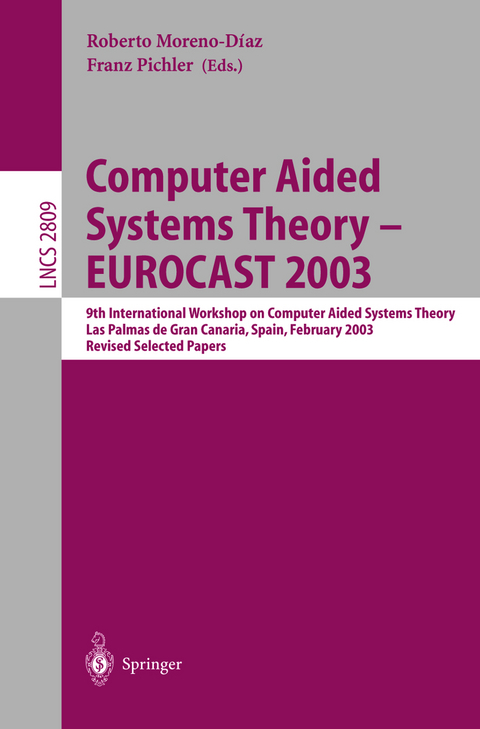
Computer Aided Systems Theory - EUROCAST 2003
Springer Berlin (Verlag)
978-3-540-20221-9 (ISBN)
Complex Systems Tools and Applications.- On Modeling and Simulation of Flows of Water by 3D-Cellular Automata.- Representation and Processing of Complex Knowledge.- How Many Rounds to KO?, or Complexity Increase by Cryptographic Map Iteration.- A Non-standard Genetic Algorithm Approach to Solve Constrained School Timetabling Problems.- Application of Uncertain Variables to Task and Resource Distribution in Complex Computer Systems.- A Framework for Modelling the User Interaction with a Complex System.- A Categorical Approach to NP-Hard Optimization Problems.- Logic and Formal Tools.- A Formulation for Language Independent Prelogical Deductive Inference.- Multi-agent Simulation in Random Game Generator.- The Zero Array: A Twilight Zone.- Invariants and Symmetries among Adaptive Agents.- Generalizing Programs via Subsumption.- Social and Intelligent Systems.- Modeling with Archetypes: An Effective Approach to Dealing with Complexity.- Equal Opportunities Analysis in the University: The Gender Perspective.- Approximate Solutions to Semi Markov Decision Processes through Markov Chain Montecarlo Methods.- Knowledge Base for Evidence Based Medicine with Bioinformatics Components.- Diversified Approach to Methodology and Technology in Distributed Intelligent Building Systems.- Temporal Approaches in Data Mining. A Case Study in Agricultural Environment.- Personalized Guided Routes in an Adaptive Evolutionary Hypermedia System.- Temporal Data Management and Knowledge Acquisition Issues in Medical Decision Support Systems.- Distributed Computing.- Development of a Scalable, Fault Tolerant, and Low Cost Cluster-Based e-Payment System with a Distributed Functional Kernel.- Generative Communication with Semantic Matching in Distributed Heterogeneous Environments.- Mapping NautilusLanguage into Java: Towards a Specification and Programming Environment for Distributed Systems.- Design of a Medical Application Using XML Based Data Interchange.- Partial-Order Reduction in Model Checking Object-Oriented Petri Nets.- On the Strong Co-induction in Coq.- Autonomous and Control Systems.- A Throttle and Brake Fuzzy Controller: Towards the Automatic Car.- ADVOCATE II: ADVanced On-Board Diagnosis and Control of Autonomous Systems II.- Segmentation of Traffic Images for Automatic Car Driving.- Vision Based Intelligent System for Autonomous and Assisted Downtown Driving.- Using Fractional Calculus for Lateral and Longitudinal Control of Autonomous Vehicles.- Computational Methods in Biomathematics.- Recent Advances in the Walking Tree Method for Biological Sequence Alignment.- Towards Some Computational Problems Arising in Biological Modeling.- Single Point Algorithms in Genetic Linkage Analysis.- A Self-adaptive Model for Selective Pressure Handling within the Theory of Genetic Algorithms.- Computational Methods for the Evaluation of Neuron's Firing Densities.- Developing the Use of Process Algebra in the Derivation and Analysis of Mathematical Models of Infectious Disease.- On Representing Biological Systems through Multiset Rewriting.- Natural and Artificial Neural Nets.- A Model of Neural Inspiration for Local Accumulative Computation.- Emergent Reasoning from Coordination of Perception and Action: An Example Taken from Robotics.- Inverse Kinematics for Humanoid Robots Using Artificial Neural Networks.- Neurosymbolic Integration: The Knowledge Level Approach.- On Parallel Channel Modeling of Retinal Processes.- Geometric Image of Statistical Learning (Morphogenetic Neuron).- Systems and Computational Tools for Neuronal Retinal Models.-Neuroinformatics and Neuroimaging.- A Novel Gauss-Markov Random Field Approach for Regularization of Diffusion Tensor Maps.- Coloring of DT-MRI Fiber Traces Using Laplacian Eigenmaps.- DT-MRI Images : Estimation, Regularization, and Application.- An Efficient Algorithm for Multiple Sclerosis Lesion Segmentation from Brain MRI.- Dynamical Components Analysis of FMRI Data: A Second Order Solution.- Tensor Field Regularization Using Normalized Convolution.- Volumetric Texture Description and Discriminant Feature Selection for MRI.- White Matter Mapping in DT-MRI Using Geometric Flows.- Anisotropic Regularization of Posterior Probability Maps Using Vector Space Projections. Application to MRI Segmentation.- Fast Entropy-Based Nonrigid Registration.- Image Processing.- 3D Reconstruction from a Vascular Tree Model.- ESKMod, a CommonKADS Knowledge Model Integrating Multiple Classic Edge Based Segmentation Algorithms.- Frequency Analysis of Contour Orientation Functions for Shape Representation and Motion Analysis.- Preprocessing Phase in the PIETSI Project (Prediction of Time Evolution Images Using Intelligent Systems).- Devices to Preserve Watermark Security in Image Printing and Scanning.
| Erscheint lt. Verlag | 13.10.2003 |
|---|---|
| Reihe/Serie | Lecture Notes in Computer Science |
| Zusatzinfo | XI, 677 p. |
| Verlagsort | Berlin |
| Sprache | englisch |
| Maße | 155 x 235 mm |
| Gewicht | 1029 g |
| Themenwelt | Informatik ► Weitere Themen ► CAD-Programme |
| Schlagworte | Automata • Autonomous Systems • Complex Systems • Computer aided system theory • Coq • Data Mining • formal methods • Genetic algorithms • Hybrid Systems • Image Processing • Information Theory • intelligent control systems • Logic • Modeling • Neuroinformatics • Reactive Systems • Robotics • Simulation • Textur |
| ISBN-10 | 3-540-20221-8 / 3540202218 |
| ISBN-13 | 978-3-540-20221-9 / 9783540202219 |
| Zustand | Neuware |
| Haben Sie eine Frage zum Produkt? |
aus dem Bereich


